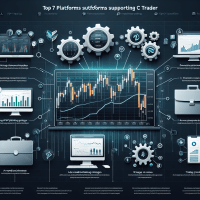Top 7 Platforms supporting cTrader in Prop Trading
Prop trading requires a blend of robust technology and deep expertise in strategy development, backtesting, and risk management. In today’s competitive market, selecting the right platform that supports cTrader is critical for achieving success. This blog post provides an expert-level analysis of the top 7 platforms, detailing their unique features, backtesting capabilities, regulatory compliance, and integration options to empower both emerging and seasoned prop traders.
Why Platform Choice is Critical in Prop Trading
Choosing a platform extends beyond a simple user interface. For prop trading firms, it is about harnessing robust backtesting, ensuring data integrity, and integrating seamlessly with brokerage and risk management systems. Advanced backtesting isn’t merely about processing historical data; it involves automated parameter optimization, scenario analysis, and out-of-sample testing. As of October 2023, regulatory frameworks such as MiFID II, ESMA, and NFA place additional emphasis on transparency, risk controls, and data quality in trading strategies.
Advanced Backtesting Strategies: Mitigating Common Pitfalls
Backtesting is an indispensable process, yet pitfalls like overfitting, survivorship bias, look-ahead bias, and data snooping can distort performance results. In practice, walk-forward optimization and out-of-sample testing help in assessing strategy robustness. Below are key components of a sound backtesting process:
- Walk-Forward Optimization: Regularly re-calibrating strategies to adapt to market changes.
- Out-of-Sample Testing: Segregating data to validate strategies before live deployment.
- Integrated Report Generation: Automated reports that highlight key metrics such as Sharpe ratios, drawdown, and profit factors enable data-driven decisions.
In addition, integrating backtesting results into a forward testing (paper trading) phase ensures the strategy performs under live market conditions before capital is risked.
Comparison of Top 7 Platforms supporting cTrader
The following detailed comparison table outlines the strengths of each platform in terms of backtesting, data quality, integration, pricing, and specific suitability for prop firms and retail traders.
| Platform | Backtesting Features | Data Quality | Integration | Pricing & Use Case |
|---|---|---|---|---|
| cTrader | Robust real-time backtesting with automated parameter scanning | Deep historical data for forex and CFDs | Direct broker connections, API integrations available | Competitive pricing; ideal for both prop firms and advanced retail traders |
| TradingView | Script-based backtesting with Pine Script, event-driven analysis | Reliable data feeds for multiple asset classes | API support for broker and third-party tool integration | Freemium model; widely used for strategy visualization and iteration |
| MetaTrader 5 | Backtesting using MQL5, supports optimization and stress testing | Comprehensive historical data across major markets | Extensive broker integration and third-party add-ons | Cost-effective, popular with institutional and advanced retail traders |
| NinjaTrader | Advanced, event-driven backtesting, customization via C# | Quality historical and real-time data | Deep integration with brokers and custom analytics tools | Subscription-based; preferred by professional traders and quants |
| QuantConnect | Algorithmic backtesting with cloud computing, supports multiple languages | Access to extensive historical datasets including equities, forex, and crypto | Robust API and integration with brokerages | Free tier available; ideal for quant strategies at institutional levels |
| ProRealTime | Vectorized backtesting with detailed report generation | High-quality real-time and historical market data | Offers API and integration with technical analysis software | Subscription-based; suited for both individual traders and prop firms |
| TraderSync | Automated backtesting integrated with trade analytics | Comprehensive trade history and performance metrics | Seamless integration with multiple trading platforms | Affordable; excellent for performance tracking and compliance in prop trading |
Deep Dive: How Automated Backtesting Enhances Prop Trading Success
For prop trading, automation in backtesting accelerates the process from concept to live deployment. Consider a case study from an established prop firm:
- Case Study: Anonymous Prop Trading Firm
- Strategy Development: The team developed a mean-reversion strategy tailored to forex. They faced issues with overfitting and data imperfections.
- Challenge: High sensitivity to parameter changes and survivorship bias in historical data.
- Solution: Switching to an event-driven backtesting approach using a combination of cTrader’s native tools and QuantConnect’s cloud-based analysis minimized overfitting. Automated parameter optimization and stress testing further refined their strategy.
- Result: Improved Sharpe ratio by 35% and reduced the maximum drawdown by 20%, validating the strategy’s robustness through extensive walk-forward analysis.
This case study illustrates the power of combining multiple platforms to harness both cTrader’s execution excellence and external backtesting capabilities.
Implementing Advanced Backtesting: A Practical Guide
Below is a step-by-step guide for integrating advanced backtesting functionality into your prop trading framework:
- Data Sourcing: Secure high-quality historical data (tick data preferred) from reliable sources. Platforms like NinjaTrader and MetaTrader 5 offer deep data archives.
- Parameter Optimization: Use automated tools available in TradingView or QuantConnect to run multiple parameter sets. Beware of overfitting by including out-of-sample data testing.
- Scenario Analysis & Stress Testing: Simulate adverse market conditions. Leverage ProRealTime’s vectorized backtesting to calculate risk metrics like maximum drawdown, Sharpe ratio, and profit factor.
- Integration with Live Testing: Run your strategy in a simulated or paper trading environment. Platforms such as cTrader and TraderSync allow smooth transitions to live execution while monitoring key performance indicators.
- Continuous Monitoring: After live deployment, continuously review performance, addressing any discrepancies between backtested and forward-tested outcomes.
Expert Guidance & Pro Tips
Pro Tip: Always incorporate walk-forward analysis alongside traditional backtesting. This not only validates your strategy against changing market dynamics but also builds confidence before live trading.
Industry Insight: Many top prop firms maintain in-house risk management checklists. For example, a comprehensive Risk Management Checklist should include stop-loss limits, profit-taking targets, and regular signal correlation reviews. Download our sample checklist at the end of this article to fine-tune your process.
Integration, Compliance, and Future Trends
Regulatory frameworks such as MiFID II, ESMA regulations, and NFA rules now mandate strict adherence to transparent backtesting and robust risk management. Prop trading strategies must now incorporate compliance tools to ensure alignment with these standards. In addition, the future of prop trading lies in the integration of machine learning models and real-time data analytics to outperform traditional methods.
For further reading, check out our articles on advanced risk management strategies and algorithmic trading tips for prop firms.
Conclusion & Next Steps
Choosing the right platform for cTrader-supported prop trading is crucial for developing robust, stress-tested strategies. Our in-depth comparison and expert guidance provide a clear roadmap—from selecting high-quality data to automating backtesting and integrating compliance checks.
As a next step, download our detailed Risk Management Checklist and subscribe to our webinar series for expert prop trading strategies. Remember, the difference between a good trading strategy and a great one often lies in the robustness of your backtesting process.
Stay ahead in prop trading by continuously adapting your strategies with proven, automated tools, and by monitoring industry trends closely.
Content updated as of October 2023. For further consultation, please connect with our team of expert prop traders.







